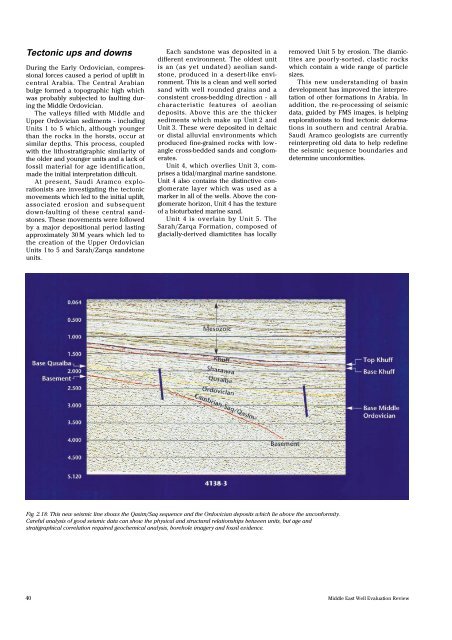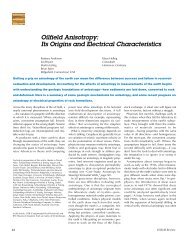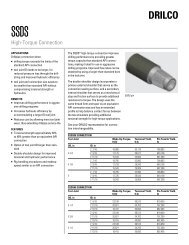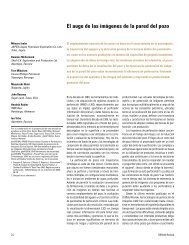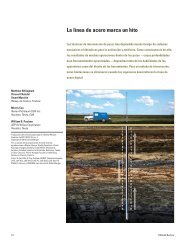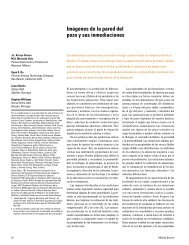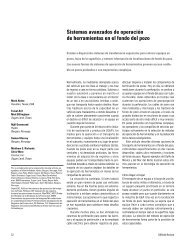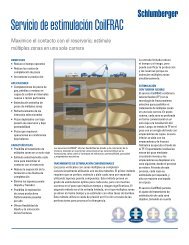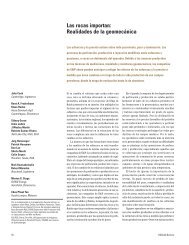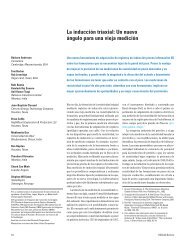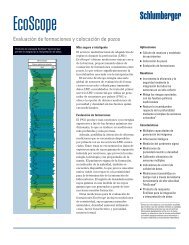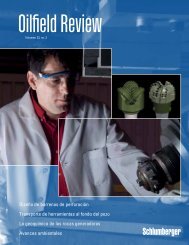Saudi Sandstone Correlations
Saudi Sandstone Correlations
Saudi Sandstone Correlations
Create successful ePaper yourself
Turn your PDF publications into a flip-book with our unique Google optimized e-Paper software.
Tectonic ups and downs<br />
During the Early Ordovician, compressional<br />
forces caused a period of uplift in<br />
central Arabia. The Central Arabian<br />
bulge formed a topographic high which<br />
was probably subjected to faulting during<br />
the Middle Ordovician.<br />
The valleys filled with Middle and<br />
Upper Ordovician sediments - including<br />
Units 1 to 5 which, although younger<br />
than the rocks in the horsts, occur at<br />
similar depths. This process, coupled<br />
with the lithostratigraphic similarity of<br />
the older and younger units and a lack of<br />
fossil material for age identification,<br />
made the initial interpretation difficult.<br />
At present, <strong>Saudi</strong> Aramco explorationists<br />
are investigating the tectonic<br />
movements which led to the initial uplift,<br />
associated erosion and subsequent<br />
down-faulting of these central sandstones.<br />
These movements were followed<br />
by a major depositional period lasting<br />
approximately 30 M years which led to<br />
the creation of the Upper Ordovician<br />
Units 1 to 5 and Sarah/Zarqa sandstone<br />
units.<br />
Each sandstone was deposited in a<br />
different environment. The oldest unit<br />
is an (as yet undated) aeolian sandstone,<br />
produced in a desert-like environment.<br />
This is a clean and well sorted<br />
sand with well rounded grains and a<br />
consistent cross-bedding direction - all<br />
characteristic features of aeolian<br />
deposits. Above this are the thicker<br />
sediments which make up Unit 2 and<br />
Unit 3. These were deposited in deltaic<br />
or distal alluvial environments which<br />
produced fine-grained rocks with low -<br />
angle cross-bedded sands and conglomerates.<br />
Unit 4, which overlies Unit 3, comprises<br />
a tidal/marginal marine sandstone.<br />
Unit 4 also contains the distinctive conglomerate<br />
layer which was used as a<br />
marker in all of the wells. Above the conglomerate<br />
horizon, Unit 4 has the texture<br />
of a bioturbated marine sand.<br />
Unit 4 is overlain by Unit 5. The<br />
Sarah/Zarqa Formation, composed of<br />
glacially-derived diamictites has locally<br />
Fig. 2.18: This new seismic line shows the Qasim/Saq sequence and the Ordovician deposits which lie above the unconformity.<br />
Careful analysis of good seismic data can show the physical and structural relationships between units, but age and<br />
stratigraphical correlation required geochemical analysis, borehole imagery and fossil evidence.<br />
removed Unit 5 by erosion. The diamictites<br />
are poorly-sorted, clastic rocks<br />
which contain a wide range of particle<br />
sizes.<br />
This new understanding of basin<br />
development has improved the interpretation<br />
of other formations in Arabia. In<br />
addition, the re-processing of seismic<br />
data, guided by FMS images, is helping<br />
explorationists to find tectonic deformations<br />
in southern and central Arabia.<br />
<strong>Saudi</strong> Aramco geologists are currently<br />
reinterpreting old data to help redefine<br />
the seismic sequence boundaries and<br />
determine unconformities.<br />
40 Middle East Well Evaluation Review


